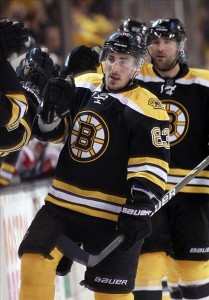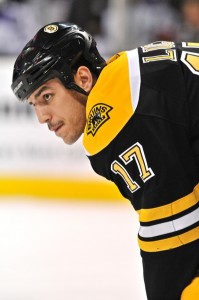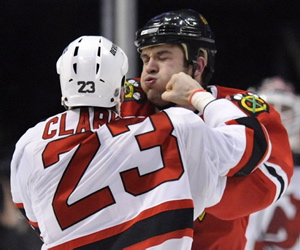Warning: This article contains words that suggest the writer is pro-hockey fights. If you are a reader who is against the idea, you may want to stop reading now. But since you clicked to come to this page, you should probably proceed anyway.
“Like a cell phone that distracts an actor on Broadway, a fight in hockey stops something good, and the play doesn’t continue afterwards at the same intensity.”
Those words come courtesy of BanHockeyFights.com, a website dedicated to – you guessed it – removing fights from hockey.
“By saying fighting is necessary to the game, you’re implying two things: that pure hockey is boring, and that hockey players are dumber than baseball players, basketball players, and football players, because hockey players can’t control their manly urges to fight while all the others do.”
Same idea, same website, similar words. And once again, they’re completely ridiculous.
In the years I have been watching various levels of hockey, I cannot recall an instance where a battle between two players ruined the intensity of the game. Almost every time, those fights are what increase the intensity of the matchup. Hardly ever have I seen a tilt that has lowered a game’s intensity – and I say hardly because there has to have been at least one fight in hockey history that made players yawn.
The Players
It’s not as though fans are the only ones who feel fighting needs to stay. Many players truly believe fighting is a part of the game.
'I think you really have to understand the game and kind of understand the (dressing) room to know what it's like to be on a bench when a guy fights,' Bruins forward Brad Marchand said before a victory over the Toronto Maple Leafs. 'For fans that think that fighting has no part of the game, they don't really know what they're talking about.'

Brad Marchand is one of many players who support hockey fights. (Greg M. Cooper-US PRESSWIRE)
'It gets guys excited, its gets us amped up,' Marchand continued. 'It's more for the fact that we want to go to bat for [the player who fights], we want to respond for him. We have tremendous respect for guys who [fight]. I think it really pushes a team to get excited and start playing better.'
Thank you, Brad.
The Safety Issue
Discussion surrounding hockey fights had slowed down a bit in a recent weeks, but a tilt in a game between the Toronto Maple Leafs and Ottawa Senators started up the talking once again.
David Dziurzynski of Ottawa and Toronto’s Frazer McLaren dropped the mitts less than a minute into the most recent edition of the Battle of Ontario. The video of the scrap is at the top of this post – if you haven’t seen it yet, please do so now.
Long story short, McLaren catches Dziurzynski with a right that collapses the Sens forward to the ice face-first. Frankly, it looked ugly, and for many fans in attendance or watching at home, particularly Ottawa supporters, it was hard to watch.
But that doesn’t mean it was bad for the game. Just ask the guy who threw the punch.
'I asked [Dziurzynski if he wanted to fight] and actually he said no and so I didn't think we were going to go and then he ended up dropping his stuff when the puck dropped,” McLaren explained when asked about the fight. “It was a lucky punch. It happens sometimes.”
Dziurzynski suffered a concussion as a result of the fight, as was obvious when he couldn’t skate off the ice under his own power. These things happen, and it’s just part of the game.
It’s not as though Dziurzynski was jumped, it’s not like McLaren just started pounding on him when the Ottawa rookie wasn’t ready. Dziurzynski made the choice the drop his gloves, and he lost the fight. That’s just the way it goes. As even McLaren said afterwards, sometimes you win, sometimes you don’t.
What’s even more: McLaren actually looked as if he felt bad after it happened. The look on his face showed sympathy. He didn’t skate away throwing his arms in the air, trying to pump up the crowd, and he didn’t stand there and taunt Dziurzynski. He just skated away, went straight to the penalty box, and didn’t make a point of showing everyone he just knocked someone out. It was an example of the class fighters have in the National Hockey League; they’ve done their job, they know it, and they move on. Nothing else needed to be done.
The fighting isn’t the safety issue. Cheap shots and head hits are the real issue surrounding concussions and player safety. That is what needs to be removed from hockey. Taking out fighting will only increase dangerous situations. As soon as fighting is removed, cheap shots will go up, mostly because the hitter won’t have a real fear of retribution. Players have a full right to be protected, and keeping fighting in and cracking down on headshots to get those hits out is the best way to ensure protection at the moment.

Milan Lucic has no real issues with fighting. (Icon SMI)
All The Rink’s A Stage
Now, of course, the issue of staged fighting arises. And yet again, there are many players who don’t see a big problem.
'I definitely don't have a problem with staged fighting at all,' Bruins forward Milan Lucic said in a Sportsnet article. 'I never have and I don't think I ever will.”
Keep in mind that Lucic is a player who has thrown more than a few fists on the ice. As a younger player coming up through the Western Hockey League, his physicality and work ethic are what made him stand out.
Staged fighting in itself is very much a controversial issue. Some, such as The Hockey Writers’ Katie Flynn, believe staged fighting has no place in hockey. Others, such as myself, are of the belief that fighting belongs in the game, whether it’s staged or instantaneous.
The Dziurzynski-McLaren tilt was certainly staged. And many of the sport’s fights are staged right off a faceoff. But they’re still part of the game because of the emotional highs they create, and more often than not, they’re done to spark a team to victory. Gaining a competitive edge is crucial to sporting success; fighting is just another method of finding that advantage.
Shoutout to William Shakespeare for the header.
The Right to An Opinion
Everyone as the right to have their own opinions on an issue. In this case, there are two sides to the controversy: one either supports fighting, or they don’t. Media members and writers from across the globe and all levels of hockey have weighed in on this issue. Currently, there seems to be an even split right down the middle.
Almost immediately after Dziurzynski was knocked out in his recent fight, there was an outcry for fighting to be banned from the sport.
“This column is going to rail against fighting in hockey,” wrote The Hockey News’ senior writer Ken Campbell at the top of a post shortly after McLaren’s knockout. “If that troubles you, feel free to move on and mutter under your breath ' or in the comments section ' about how pantywaists like me should go and cover figure skating or synchronized swimming.”
Fair enough. There’s nothing wrong with having an opinion. Quite honestly, the anti-fighting opinion is one many hockey fans support. But after a while, there comes a certain point where everyone needs to understand that it’s the players’ opinions that really count.

David Clarkson of New Jersey (in white) and Brent Seabrook of Chicago.
When a player such as Brad Marchand fully believes fighting needs to stay in the game, that means something. Marchand is an agitator who is often targeted on the ice because of his so-called “dirty” style. But even he – one who is often challenged to fight – feels players need to be allowed to drop the mitts.
Survey Says
An online survey issued by Angus Reid Public Opinion found that “only eight per cent of people polled said they felt fighting was important to the game, while 67 percent of people who identified themselves as hockey fans deemed on-ice fights as 'not important to hockey.’” And “more than three-quarters of people polled ' 78 per cent — said they'd ban on-ice fights from Canada's major junior elite hockey leagues altogether.”
'Staged fights, and indeed all fights in hockey should be banned, as they are in many great sports such as soccer,' said Dr. Charles Tator, founder of ThinkFirst Canada. 'We would have a safer game if we banned fighting.'
See, this is where everything crumbles. Comparing hockey to the “great sport” of soccer, one in which grown men flop to the ground as if they’ve been shot and get up a few seconds later perfectly fine, is where the line needs to be drawn. The two sports are different games with different rules, and that’s all great. But saying fighting in hockey needs to be banned because it isn’t allowed in soccer either, that’s making what’s essentially a false comparison.
There is absolutely nothing wrong with having a strong opinion on fighting in hockey, regardless of which side of the fence one is on. Both sides have pros and cons, and that’s all fine and dandy. But at the moment, most players seem to support keeping fighting in the game.
A Sports Illustrated poll published in March of 2012 surveyed 202 NHL players regarding their opinion on the topic of removing fighting. The result: 99.5 percent of players said fighting shouldn’t be banned.
What it all comes down to is this: It’s the men on the ice who are putting themselves at risk. And most of the time, this is a risk voluntarily taken. Thus, they should hold the power. Until that changes, no one should be trying to convince players that fighting should be banned.
The athletes are the ones who need to be making the call when deciding whether or not fighting should remain a part of hockey.
___________________________________________
Email: davidoconnorhockey@gmail.com
Twitter: @DavidOConnorTHW
Author information
This article was originally published at: The Hockey Writers.
0 komentar:
Posting Komentar